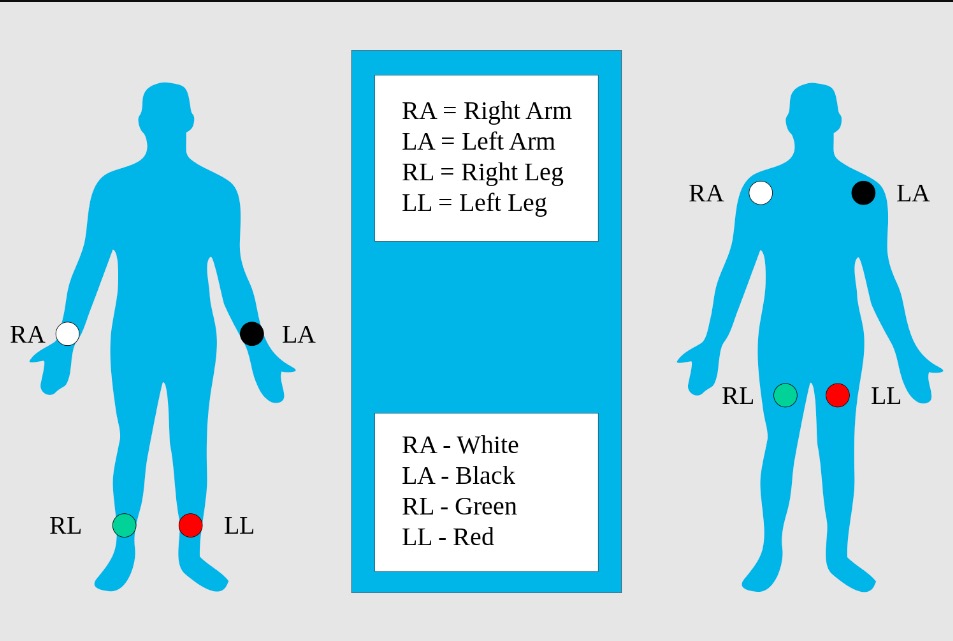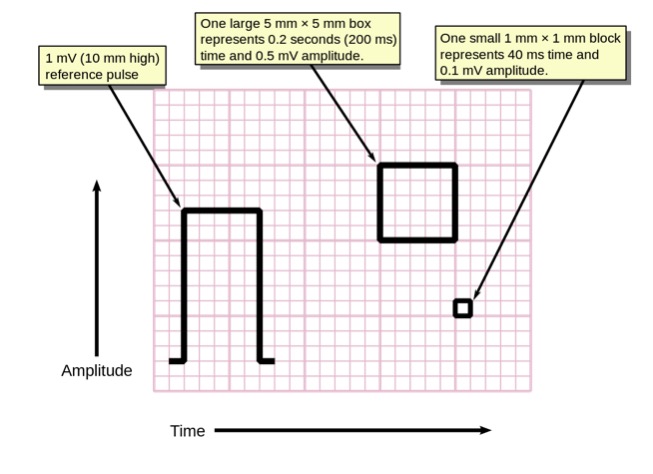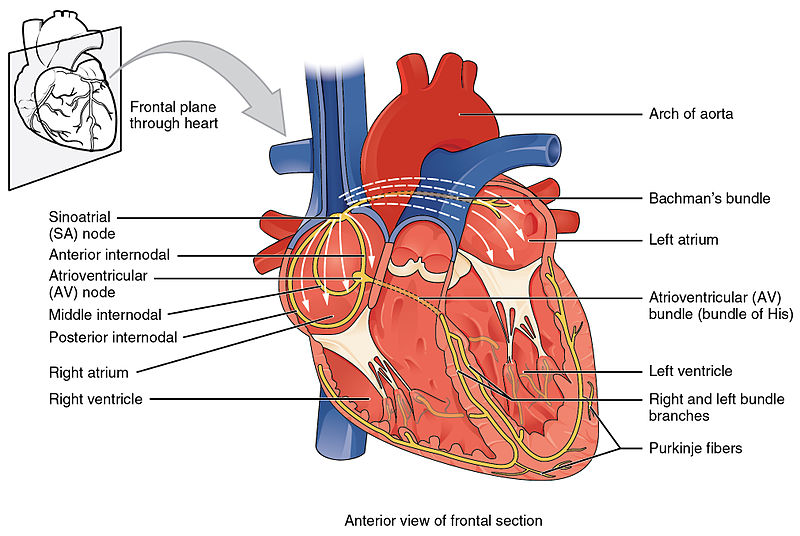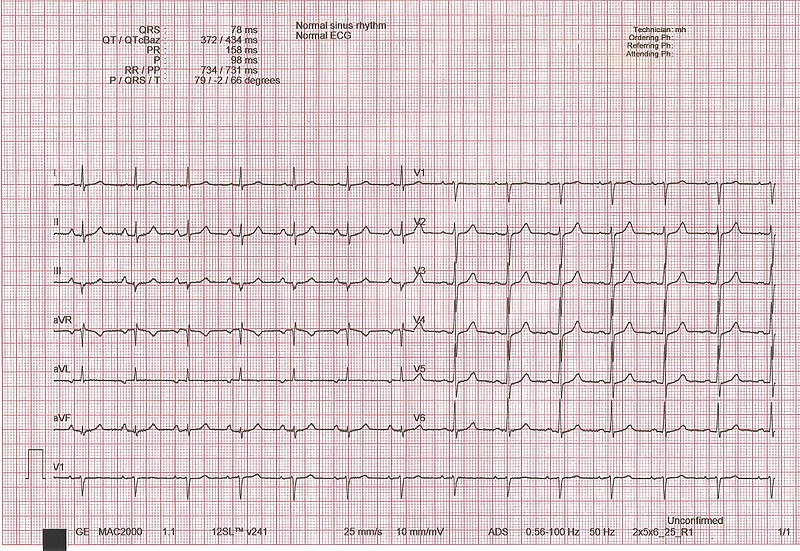How Do I Understand the Readings of Ecg Results
Reach Mastery of Medical Concepts
Tabular array of Contents
Overview
In 1902 the electrocardiogram (ECG) was invented by Willem Einthoven, a Dutch dr.. Einthoven received the 1924 Nobel Prize in Physiology or Medicine for the invention.
Terminology
Electrocardiogram is abbreviated/referred to every bit:
- ECG: American spelling
- EKG: European spelling
- The terms may exist used interchangeably.
- Clinically referred to as a 12-lead ECG
ECG electrodes and leads
- Conductive electrodes are affixed to the skin Skin The pare, also referred to equally the integumentary system, is the largest organ of the body. The skin is primarily equanimous of the epidermis (outer layer) and dermis (deep layer). The epidermis is primarily equanimous of keratinocytes that undergo rapid turnover, while the dermis contains dense layers of connective tissue. Structure and Role of the Skin with agglutinative backing.
- 10 electrodes are required to produce a 12-lead ECG:
- 1 electrode is affixed to each limb:
- Historically, a resting ECG was affixed to the distal limb.
- In the clinical setting, a resting ECG is affixed to the thorax near the corresponding limb.
- 6 electrodes are placed on the precordium:
- V1: fourth intercostal space (ICS), RIGHT margin of the sternum Sternum A long, narrow, and flat bone normally known equally breastbone occurring in the midsection of the anterior thoracic segment or breast region, which stabilizes the rib cage and serves equally the point of origin for several muscles that movement the artillery, caput, and neck. Chest Wall
- V2: quaternary ICS, LEFT margin of the sternum Sternum A long, narrow, and flat bone unremarkably known as breastbone occurring in the midsection of the anterior thoracic segment or breast region, which stabilizes the rib cage and serves as the betoken of origin for several muscles that motility the arms, caput, and neck. Chest Wall
- V4: 5th ICS, midclavicular line
- V3: midway betwixt V2 and V4
- V5: 5th ICS, anterior axillary line
- V6: fifth ICS, midaxillary line
- 1 electrode is affixed to each limb:
- 12 lead is created by ECG machine/software voltages transmitted from electrodes:
- 3 bipolar limb leads (recording obtained from pairs of limb electrodes):
- I: right arm Arm The arm, or "upper arm" in common usage, is the region of the upper limb that extends from the shoulder to the elbow joint and connects inferiorly to the forearm through the cubital fossa. It is divided into ii fascial compartments (anterior and posterior). Arm (-) and left arm Arm The arm, or "upper arm" in common usage, is the region of the upper limb that extends from the shoulder to the elbow joint and connects inferiorly to the forearm through the cubital fossa. It is divided into 2 fascial compartments (inductive and posterior). Arm (+) electrodes
- 2: correct arm Arm The arm, or "upper arm" in common usage, is the region of the upper limb that extends from the shoulder to the elbow articulation and connects inferiorly to the forearm through the cubital fossa. Information technology is divided into 2 fascial compartments (inductive and posterior). Arm (-) and left leg Leg The lower leg, or just "leg" in anatomical terms, is the part of the lower limb between the genu and the ankle joint. The bony structure is equanimous of the tibia and fibula bones, and the muscles of the leg are grouped into the anterior, lateral, and posterior compartments by extensions of fascia. Leg (+) electrodes
- III: left arm Arm The arm, or "upper arm" in common usage, is the region of the upper limb that extends from the shoulder to the elbow articulation and connects inferiorly to the forearm through the cubital fossa. Information technology is divided into ii fascial compartments (anterior and posterior). Arm (-) and left leg Leg The lower leg, or just "leg" in anatomical terms, is the office of the lower limb between the articulatio genus and the ankle joint. The bony construction is composed of the tibia and fibula bones, and the muscles of the leg are grouped into the anterior, lateral, and posterior compartments past extensions of fascia. Leg (+) electrodes
- Einthoven triangle: A schematic triangle made from the 3 electrodes involved in creating leads I, 2, and III.
- 3 augmented unipolar limb leads (recording obtained from a limb electrode and the key concluding):
- Augmented Vector Right (aVR): right arm Arm The arm, or "upper arm" in common usage, is the region of the upper limb that extends from the shoulder to the elbow joint and connects inferiorly to the forearm through the cubital fossa. It is divided into 2 fascial compartments (inductive and posterior). Arm (+) electrode and the central terminal (-)
- Augmented Vector Left (aVL): left- arm Arm The arm, or "upper arm" in common usage, is the region of the upper limb that extends from the shoulder to the elbow joint and connects inferiorly to the forearm through the cubital fossa. It is divided into 2 fascial compartments (inductive and posterior). Arm (+) electrode and the central terminal (-)
- Augmented Vector Foot Human foot The foot is the terminal portion of the lower limb, whose primary function is to bear weight and facilitate locomotion. The pes comprises 26 bones, including the tarsal basic, metatarsal bones, and phalanges. The basic of the foot course longitudinal and transverse arches and are supported by various muscles, ligaments, and tendons. Foot (aVF): left leg Leg The lower leg, or just "leg" in anatomical terms, is the part of the lower limb between the knee and the talocrural joint articulation. The bony structure is composed of the tibia and fibula bones, and the muscles of the leg are grouped into the anterior, lateral, and posterior compartments by extensions of fascia. Leg electrode (+) and the central concluding (-)
- half-dozen precordial leads (recording obtained from the respective chest electrode and the central last):
- V1, V2: septal leads
- V3, V4: inductive leads
- V5, V6: lateral leads
- 3 bipolar limb leads (recording obtained from pairs of limb electrodes):
-

Limb electrodes: standard placement of the limb electrodes (left paradigm) and modified placement (right image) for ECG
Epitome: "Limb leads, standard placement of the limb leads for electrocardiography" by MoodyGroove. License: Public Domain -

Proper placement of the precordial electrodes for ECG
Epitome: "Precordial leads in ECG" by Mikael Häggström. License: CC0 1.0 -

Einthoven triangle
Image: "Einthoven triangle" past Katrin Litzkow. License: Public Domain
ECG tracing
- Organized as a graph in boxes:
- Small box = 1 10 ane mm
- Large box = 5 x 5 mm (five small boxes)
- 10 and Y axes:
- Ten axis Axis The second cervical vertebra. Vertebral Column = fourth dimension in seconds
- Y centrality Axis The 2d cervical vertebra. Vertebral Column = voltage in mV
- X- axis Axis The second cervical vertebra. Vertebral Column utility:
- ECG tracing speed = 25 mm/second (25 small boxes/second or 5 large boxes/second)
- 1 modest box = 0.04 second
- i large box = 0.2 second
- Allows for heart rate Center rate The number of times the heart ventricles contract per unit of measurement of time, usually per minute. Cardiac Physiology adding and rhythm determination:
- Bradycardia vs. tachycardia
- Regular vs. irregular
- Allows for measurement of clinically relevant intervals and durations
- Y- centrality Centrality The 2d cervical vertebra. Vertebral Column utility:
- 1 modest box = 0.1 mV
- Allows for decision of voltage amplitude of ECG waveforms
- Aamplitude correlates with electromechanically coupled events in the cardiac cycle Cardiac cycle The cardiac cycle describes a consummate contraction and relaxation of all four chambers of the heart during a standard heartbeat. The cardiac bicycle includes 7 phases, which together describe the wheel of ventricular filling, isovolumetric wrinkle, ventricular ejection, and isovolumetric relaxation. Cardiac Bicycle :
- No deflection = no cardiac conduction or contraction (e.thousand., isoelectric baseline)
- Small deflection = low voltage associated with thin myocardium Myocardium The muscle tissue of the center. It is equanimous of striated, involuntary muscle cells connected to form the contractile pump to generate blood catamenia. Anatomy of the Heart (atria) and modest contraction (due east.g., P wave)
- Large deflection = high voltage associated with thick myocardium Myocardium The muscle tissue of the heart. It is composed of striated, involuntary muscle cells connected to class the contractile pump to generate blood menstruum. Anatomy of the Heart (ventricle) and forceful contraction (e.g., QRS complex)

ECG voltage pulse and size of squares
Paradigm: "Measuring time and voltage with ECG graph paper" past Markus Kuhn. License: Public DomainComponents
A normal ECG tracing volition take several anticipated and reproducible components corresponding to electromechanical events in the cardiac wheel Cardiac bicycle The cardiac bike describes a complete contraction and relaxation of all iv chambers of the heart during a standard heartbeat. The cardiac cycle includes seven phases, which together draw the bike of ventricular filling, isovolumetric wrinkle, ventricular ejection, and isovolumetric relaxation. Cardiac Cycle .
Electrical impulse of heart contraction
- Isoelectric baseline:
- Apartment tracing free of positive or negative deflections in between waves and/or complexes
- Represents periods of electrical inactivity in the cardiac bike Cardiac wheel The cardiac bike describes a consummate contraction and relaxation of all 4 chambers of the heart during a standard heartbeat. The cardiac wheel includes 7 phases, which together describe the cycle of ventricular filling, isovolumetric contraction, ventricular ejection, and isovolumetric relaxation. Cardiac Cycle
- Waves:
- P wave:
- Represents atrial depolarization Depolarization Membrane Potential
- Positive deflection in inferior/lateral leads
- T wave:
- Represents ventricular repolarization Repolarization Membrane Potential
- Positive deflection
- P wave:
- Intervals:
- PR interval:
- From the beginning of the P wave to the initial defection of the QRS circuitous
- Represents the time needed for the electrical impulse to travel from the sinoatrial (SA) node to the atrioventricular (AV) node
- QT interval:
- From the beginning of the QRS circuitous to the terminate of the T wave
- Represents ventricular depolarization Depolarization Membrane Potential , contraction, and repolarization Repolarization Membrane Potential
- RR RR Relative risk (RR) is the risk of a disease or condition occurring in a group or population with a particular exposure relative to a control (unexposed) group. Measures of Risk interval:
- The fourth dimension betwixt 2, successive QRS complexes
- Used to calculate middle rate Heart rate The number of times the heart ventricles contract per unit of fourth dimension, usually per minute. Cardiac Physiology
- PR interval:
- Segments:
- PQ segment: isoelectric segment between the P wave and initial deflection of the QRS circuitous
- ST segment: isoelectric segment betwixt the S wave and the initial deflection of the T wave
- TP segment: isoelectric baseline betwixt the T wave and the initial deflection of the P wave
- QRS complex:
- Represents ventricular depolarization Depolarization Membrane Potential
- Composed of 3 waves:
- Q wave: negative deflection
- R moving ridge: positive deflection
- Due south wave: negative deflection
- Depending on the ECG lead monitored:
- QS wave: Positive deflection may non be credible (i.east. no R wave).
- RS wave: Negative deflection may not be apparent (i.e. no Q wave).
- QRS complex: Collective ventricular depolarization Depolarization Membrane Potential regardless of the presence or absence of all components.

Parts of ECG waveforms and intervals
Image past Lecturio. License: CC BY-NC-SA 4.0Correlation to electromechanical coupling
- The cardiac electric bicycle begins spontaneously in the SA node of the right atrium:
- ECG: termination of TP segment, onset of the P moving ridge
- Mechanical: atria infused with claret from passive venous filling:
- Vena cava: fills the right atrium
- Pulmonary veins Pulmonary veins The veins that return the oxygenated blood from the lungs to the left atrium of the heart. Lungs : fill the left atrium
- Electrical impulse of depolarization Depolarization Membrane Potential spreads throughout the atria via the internodal pathways and arrives at the AV node located in the AV septum:
- ECG: completion of the P wave:
- The atria repolarize electrically during the ventricular portions of the cardiac electric bicycle.
- Atrial repolarization Repolarization Membrane Potential is obscured by the QRS complex on ECG tracing.
- Mechanical: atrial contraction, ventricular relaxation:
- Tricuspid/mitral valves open up
- Pulmonic/aortic valves close
- Ventricles fill with blood
- ECG: completion of the P wave:
- Electrical activity is slowed considerably by specialized conductive cells in the fundamental portions of the AV node:
- ECG: PQ segment (isoelectric baseline)
- Mechanical: ventricles fill up with blood from atrial wrinkle, atria relax and passively fill with blood
- Electrical activity resumes as the cardiac impulse arrives at the quickly conducting pathways in the interventricular septum (atrioventricular packet or His packet):
- ECG: onset of Q wave
- Mechanical: ventricular septum contracts, passive atrial filling continues:
- Tricuspid/mitral valves close, chordae tendineae Chordae tendineae The tendinous cords that connect each cusp of the 2 atrioventricular centre valves to appropriate papillary muscles in the eye ventricles, preventing the valves from reversing themselves when the ventricles contract. Anatomy of the Middle taut
- Papillary muscles Papillary muscles Conical muscular projections from the walls of the cardiac ventricles, attached to the cusps of the atrioventricular valves by the chordae tendineae. Beefcake of the Heart isometrically contract to maintain the integrity of tricuspid/mitral apparatus
- Electric activeness spreads toward the noon of the heart forth the correct and left bundle branches traversing the thickest portions of the myocardium Myocardium The musculus tissue of the heart. It is composed of striated, involuntary muscle cells connected to form the contractile pump to generate blood flow. Beefcake of the Centre :
- ECG: R moving ridge
- Mechanical: continuation of ventricular costless wall contraction, passive atrial filling:
- Tricuspid/mitral valves "airship" back into the atria
- Pulmonic/aortic valves open up
- Electrical activity terminates in the Purkinje fibers Purkinje fibers Modified cardiac musculus fibers composing the concluding portion of the heart conduction organization. Beefcake of the Centre , penetrating the deepest portions of the myocardium Myocardium The muscle tissue of the heart. It is equanimous of striated, involuntary muscle cells connected to grade the contractile pump to generate blood menstruation. Beefcake of the Middle almost the endocardium Endocardium The innermost layer of the heart, comprised of endothelial cells. Anatomy of the Heart :
- ECG: S moving ridge
- Mechanical: completion of ventricular wrinkle, the continuation of passive atrial filling
- Cardiac electrical activeness plateaus briefly:
- ECG: ST segment
- Mechanical: ventricles brainstorm to relax, passive atrial filling continues:
- Tricuspid/mitral valves closed
- Pulmonic/aortic valves closed
- Ventricular repolarization Repolarization Membrane Potential :
- ECG: T moving ridge and TP segment
- Mechanical: ventricular relaxation, passive atrial filling continues:
- Pressure gradient exists between filling atria and emptied ventricles
- Ventricles begin to passively fill up
- Tricuspid/mitral valves partially open
- Another cardiac bicycle Cardiac cycle The cardiac cycle describes a complete contraction and relaxation of all four chambers of the centre during a standard heartbeat. The cardiac bicycle includes seven phases, which together describe the cycle of ventricular filling, isovolumetric contraction, ventricular ejection, and isovolumetric relaxation. Cardiac Wheel begins.
-

Cantankerous-department of the heart showing the conduction system
Image: "Conduction System of Heart" past OpenStax College. License: CC BY 3.0 -

Normal pb Two rhythm strip with standard voltage bar
Image: "Normal EKG" past StatPearls Publishing LLC. License: CC By 4.0
Systematic Estimation
- Scale (voltage and speed): standard:
- Paper/tracing speed = 25 mm/2d
- 1 mm (horizontal) = 0.04 second
- ane mm (vertical) = 0.ane mV
- Calculate eye rate Center charge per unit The number of times the eye ventricles contract per unit of measurement of time, usually per infinitesimal. Cardiac Physiology :
- Adding: divide 300 by the number of large squares between RR RR Relative risk (RR) is the risk of a disease or condition occurring in a group or population with a particular exposure relative to a control (unexposed) group. Measures of Risk intervals
- Normal middle rate Eye charge per unit The number of times the heart ventricles contract per unit of time, ordinarily per minute. Cardiac Physiology : 60–100/min
- Determine rhythm: normal sinus rhythm Sinus rhythm A middle charge per unit and rhythm driven by the regular firing of the SA node (60–100 beats per infinitesimal) Cardiac Physiology criteria:
- Normal P-wave morphology
- A regular QRS circuitous follows every P wave
- Normal, constant PR/ RR RR Relative risk (RR) is the risk of a disease or status occurring in a group or population with a particular exposure relative to a control (unexposed) group. Measures of Risk intervals
- Determine timing intervals (PR, QRS, QTC):
- Manual adding by measuring horizontal blocks
- Electronic calculation past machine/software (commonly listed in the top-left corner)
- PR interval 0.12–0.two 2nd
- QRS circuitous < 0.12 second
- QTC interval 0.30–0.46 second
- Decide mean Mean Mean is the sum of all measurements in a information set divided by the number of measurements in that data set. Measures of Central Tendency and Dispersion QRS axis Centrality The second cervical vertebra. Vertebral Cavalcade :
- Direction of QRS deflection:
- Positive: The mean Hateful Mean is the sum of all measurements in a information set up divided by the number of measurements in that data prepare. Measures of Central Tendency and Dispersion electrical vector travels towards the positive electrode in a given lead.
- Negative: The mean Mean Mean is the sum of all measurements in a data ready divided past the number of measurements in that data set up. Measures of Central Tendency and Dispersion electric vector travels away from the positive electrode in a given pb.
- Normal: -30°–100°
- Normally positive in lead Ii and pb aVF
- Direction of QRS deflection:
- Evaluate P-wave morphology by voltage size and deflection:
- Normal time < 0.12 2d
- Normally upright in lead Two and atomic number 82 aVF
- Evaluate QRS morphology and/or voltage:
- Normal duration < 0.12 second
- R moving ridge should transition in aamplitude in the precordial leads:
- Lowest voltage in V1
- Highest voltage in V6
- Evaluate ST-segment and T-wave morphology:
- ST segment:
- Flat, isoelectric segment after QRS complex, merely before T moving ridge
- Normally no depression or elevation
- T wave: normally concordant with QRS complex
- ST segment:
- Compare with prior tracings if bachelor.

Normal ECG: 12-lead tracing with a V1 rhythm strip displayed at the lesser
Image: "ECG interpretation" past Rodhullandemu. License: Public Domainmortonhatumer1995.blogspot.com
Source: https://www.lecturio.com/magazine/how-to-interpret-an-ecg/
0 Response to "How Do I Understand the Readings of Ecg Results"
Post a Comment